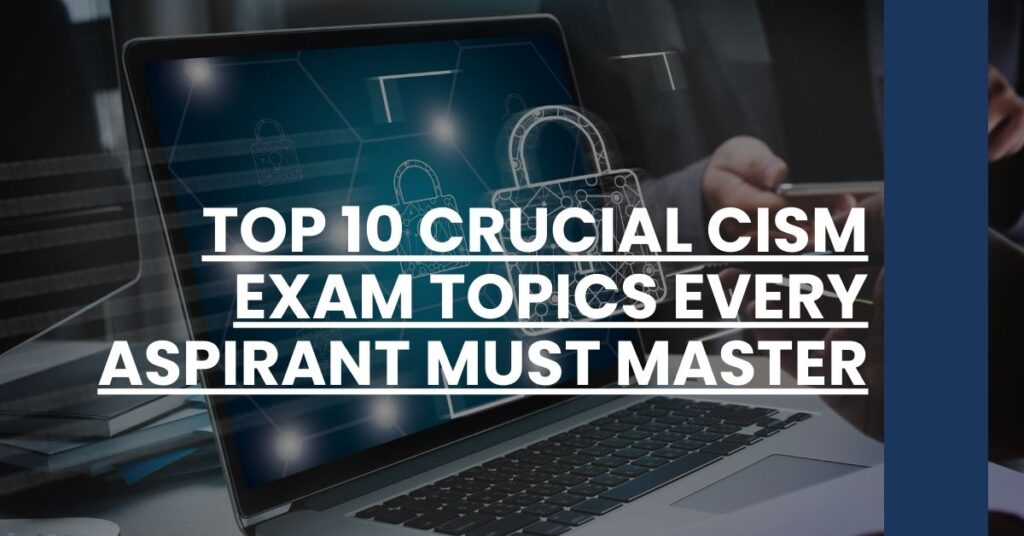Absolutely! To conquer the CISM exam and achieve a top-tier score, it is crucial to have a strong grasp of the core CISM exam topics.
In this article, we will break down the essential knowledge you need to succeed, while also providing valuable insights that go beyond the basics. By aligning your study strategy with the key elements that define successful Certified Information Security Managers, you will be well-prepared to excel on the CISM exam.
- 1. Information Security Governance
- 2. Risk Management and Compliance
- 3. Development and Management of Information Security Programs
- 4. Incident Management and Response
- 5. Information Security Leadership and Management
- 6. Integration of IT with Business Strategy
- 7. Emerging Information Security Technologies
- 8. Ethical and Legal Requirements
- 9. Business Continuity and Disaster Recovery Planning
- 10. Protection of Information Assets
- The CISM Certification Domains
- Requirements for CISM Certification
- Conclusion: Key Insights and Next Steps for Aspiring CISMs
1. Information Security Governance
When embarking on the journey to becoming a Certified Information Security Manager (CISM), understanding the heart of information security governance is imperative. Not only is it a fundamental element among CISM exam topics, but it’s the framework that supports the longevity and efficacy of an organization’s security policies.
- Strategic Alignment: Your governance model should align with the broader business strategy to ensure that information security contributes to organizational objectives.
- Risk Management: Establish a process to identify, evaluate, and manage information security risks in a way that aligns with the organization’s risk appetite.
- Value Delivery: Ensure that the investments in information security translate into value for the business.
- Performance Measurement: Develop metrics to evaluate the effectiveness and efficiency of the information security strategy and its implementation.
- Resource Management: Efficiently allocate human, financial, and technical resources to maintain and improve information security posture.
For a deeper dive into the best practices of information security governance, consider exploring resources like Infoguard’s comprehensive approach. It’s these practices that will save your organization from the consequences of cyber threats and the significant costs associated with them.
2. Risk Management and Compliance
A CISM professional’s arsenal isn’t complete without the adeptness to conduct thorough risk management and compliance. Here’s what you need to home in on:
- Risk Assessment: Prioritize and assess risks to the organization’s information.
- Risk Mitigation Strategies: Develop and implement appropriate strategies to mitigate identified risks.
- Compliance: Understand and adhere to legal, regulatory, and contractual obligations impacting information security.
To ensure that you’re on top of the game, staying abreast of the latest developments and recommendations in this domain is a must. The University of Wisconsin’s take on risk management can provide valuable insights on how to bolster your risk management strategies.
3. Development and Management of Information Security Programs
Building the blueprint for a robust information security program is both an art and a science. It demands a careful balance of technical knowledge and strategic foresight—one of the non-negotiable CISM exam topics.
- Information Security Framework: Choose and customize a framework that fits your organization.
- Security Controls: Identify the appropriate controls for protecting information assets.
- Training and Awareness: Develop programs to raise security literacy among employees.
- Security Monitoring: Implement monitoring processes to detect and respond to security events.
Ground your knowledge in authoritative guidelines, such as the Risk Management Framework propagated by NIST, which lays out a systematic approach to managing organizational risk.
4. Incident Management and Response
Mastering the discipline of incident management and response is akin to learning the art of remaining calm and focused during a storm. Here’s what should be at your fingertips:
- Preparation: Crafting an incident response plan tailored to your organization’s needs.
- Detection and Analysis: Using tools and techniques to quickly discern potential security incidents.
- Response: Containing and eradicating threats, and recovering systems to their normal status.
- Post-Incident Activities: Reviewing and learning from incidents to improve future response and prevention.
For a seamless incident response strategy, taking a leaf out of standards such as those suggested by NIST’s structured process could prove invaluable in enhancing your preparedness and response capabilities.
5. Information Security Leadership and Management
The real mark of excellence in the domain of CISM is the ability to manifest leadership and management skills in protecting an organization’s informational assets. It involves a harmonious blend of hard and soft skills:
- Strategic Planning: Shape the direction of your organization’s information security program.
- Policy Development: Craft clear and actionable security policies.
- Influencing and Advocacy: Garner support and resources for security initiatives.
- Staff Management: Lead a team of security professionals effectively.
Leadership courses and resources tailored for security managers, like those offered by SANS, can provide the skill set necessary for strategic planning and leading with authority in this space.
6. Integration of IT with Business Strategy
In the CISM realm, the integration of IT and business strategy isn’t just encouraged—it’s crucial. It ensures the seamless interplay of systems and strategic goals, making it a prominent CISM exam topic.
- Business Drivers: Understand the underlying business objectives driving IT investments.
- Alignment Processes: Regularly align IT strategy with business priorities.
- Strategic Planning: Contribute to the organization’s strategic planning efforts with a focus on IT enablement.
Effective IT and business strategy alignment, as illustrated in CIO’s comprehensive guide, is all about ensuring that every technological investment and decision pushes the business forward, meets its objectives, and provides competitive advantages. These strategies hinge on consistent communication and ongoing assessments within IT management.
7. Emerging Information Security Technologies
As the digital landscape evolves, so do the threats to information security. As a prospective Certified Information Security Manager (CISM), keeping your finger on the pulse of emerging information security technologies is not just advantageous; it’s imperative. Here’s a rundown of what you need to look out for:
- Zero Trust Model: A paradigm shift advocating “never trust, always verify,” is crucial for modern security architectures.
- Artificial Intelligence (AI) and Machine Learning (ML): These technologies elevate threat detection and behavioral analytics to new heights.
- Blockchain Technology: Beyond cryptocurrency, blockchain offers significant implications for enhancing security and integrity in various applications.
While these technologies are promising, they each carry potential security risks that you need to be cognizant of. By understanding technologies such as Zero Trust Network Access and hardware-based security, you ensure that your organization can leverage cutting-edge solutions while maintaining a secure posture.
8. Ethical and Legal Requirements
Navigating the complex world of ethical and legal requirements is a guaranteed section on the CISM exam. As an information security professional, you hold the key to not just safeguarding data but also upholding the standards of your practice:
- Ethical Behavior: Uphold and promote ethical conduct within your field, setting a high standard for privacy and respect for data.
- Regulatory Adherence: Familiarize yourself with laws and regulations such as GDPR, HIPAA, and SOX, which govern information security.
- Legal Accountability: Recognize the legal implications of security breaches and the necessity for compliance in your security strategies.
Grasp the legalities by exploring comprehensive resources like studies on identifying security requirements from legal documents, which serves as a testament to the importance of legal acumen in security governance.
9. Business Continuity and Disaster Recovery Planning
When catastrophe strikes, organizations look to their information security leaders to navigate the storm. That’s why business continuity and disaster recovery planning take precedence in the inventory of crucial CISM exam topics:
- Business Impact Analysis (BIA): Understand the effects of disruptions on your organization and prioritize the recovery efforts.
- Continuity Strategies: Establish procedures to maintain critical business functions during and after a disaster.
- Recovery Plans: Develop comprehensive plans for the quick restoration of data, infrastructure, and operations post-incident.
For insights into the subtleties of disaster recovery and how it fits into broader business continuity planning, consider resources like CSO’s basics of disaster recovery, which explain the nuances and guide the crafting of a resilient response.
10. Protection of Information Assets
The armor of any organization’s security strategy is the protection of information assets. As a proficient CISM candidate, it’s expected that you’ve mastered the craft:
- Data Encryption: Transform sensitive data into unreadable code that can only be deciphered with the right key, ensuring data confidentiality.
- Access Control: Implement stringent measures to ensure that only authorized individuals can interact with protected information.
- Security Architectures: Design secure network architectures that protect against internal and external threats.
By delving into techniques for protecting information assets, you’re not just preparing for the CISM exam but securing your organization’s most valuable treasures—its data.
The CISM Certification Domains
A firm grasp of the CISM certification domains provides a structural blueprint to direct your study efforts effectively. To make the most of your learning experience, it’s essential to grasp the balance and interconnectedness of these domains:
- Information Security Governance: Casting the strategic vision for security in alignment with business goals.
- Information Risk Management: Proactive identification and mitigation of security risks.
- Information Security Program Development and Management: Crafting and overseeing the security program that guards against threats.
- Information Security Incident Management: Preparing for and navigating through information security incidents when they occur.
A comprehensive overview of these domains contributes to a holistic understanding of the mosaic that is the CISM exam, enabling a coherent and potent approach to your studies and future responsibilities.
Requirements for CISM Certification
To attain the prestigious title of a Certified Information Security Manager, you must meet specific requirements for CISM certification. It’s a badge of honor that signifies not just knowledge but experience:
- Pass the CISM Exam: Demonstrate expertise across all CISM domains by achieving a passing score.
- Relevant Work Experience: Prove a minimum of five years of professional information security experience, with at least three years in management roles.
- Continuing Education: Engage in ongoing learning to maintain your certification and stay current in the field.
These prerequisites underscore the importance of dedication to the craft of information security management, heralding a commitment that goes beyond the achievement of a score.
Conclusion: Key Insights and Next Steps for Aspiring CISMs
As we’ve journeyed through the intricacies of CISM exam topics, the value each brings to the table for an aspiring information security manager stands clear. From governance frameworks to the latest in cybersecurity technologies, these components equip you with the knowledge necessary to lead with confidence and acumen. Your next steps involve dedicated study, practical application, and a commitment to ethical practice. Remember, the journey to CISM certification is not merely a means to an end but a pathway to becoming a linchpin in the ever-critical field of information security.

